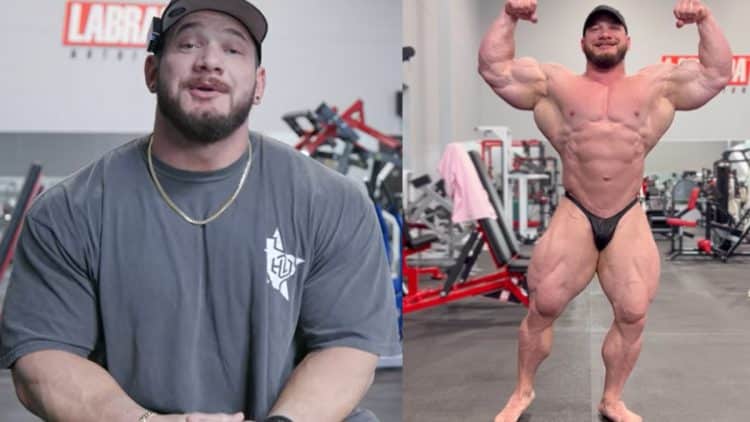Top-tier Open class competitor Hunter Labrada is in the midst of preparing his physique for another Olympia contest. In the meantime, Labrada recently shared training tips for enhanced and unenhanced athletes who are looking to make improvements inside the gym.
Hunter Labrada, son of bodybuilding Hall of Famer Lee Labrada, proved he had the tools to compete with the best in the Men’s Open division last year. He kicked off the season with a dominant first-place victory at the 2021 Chicago Pro. This performance earned Hunter an invitation to compete at Olympia.
Labrada finished fourth place at 2021 Mr. Olympia, which effectively cemented his status as one of the top bodybuilders in the world. He defeated one of his rivals Nick “The Mutant” Walker at the show but was unable to knock Big Ramy off his throne or get past Brandon Curry and Hadi Choopan.
Even though he’s been occupied building his physique lately, Hunter routinely shares training tips and insight on his growing YouTube channel. Of course, training techniques and methods vary depending on the person, but Labrada prides himself on having the answers, regardless of if an athlete is natural, or using performance-enhancing drugs.
Level Up Your Fitness: Join our 💪 strong community in Fitness Volt Newsletter. Get daily inspiration, expert-backed workouts, nutrition tips, the latest in strength sports, and the support you need to reach your goals. Subscribe for free!
Hunter Labrada says Unenhanced and Enhanced Bodybuilders ‘Should Train Low Volume, High Intensity’
During Hunter Labrada’s latest Tuesday Tip video, he started off by warning athletes not to brag about their ‘natty or not’ status.
“Enhanced versus unenhanced training programs. I’m going to preface this by saying: if you are natty — good for you. If you are enhanced — good for you. If you are either of them and you brag about it and take pride in the fact and tear others down who are the opposite — shame on you,” Hunter Labrada shared.
Before delving into tips about volume and intensity, Hunter explained the utility of steroids, and how they help with ‘enhancing recovery.’
“So, enhanced versus non-enhanced training. This is going to be a big surprise to people because of the main things I see on mine and a lot of others when we post our training, ‘yeah that’s great, but you’re enhanced, you take a bunch of steroids.’ But that aside, I want you to take a step back and think about what all of those steroids that we are taking do.”
Labrada maintains that non-enhanced lifters should still achieve the same ‘level of volume’ as other lifters that use steroids.
“They greatly enhance your recovery capabilities, meaning we can do more work in the gym versus someone who isn’t. So… what does that mean? That means the non-enhanced lifters should be at the level of volume or even a lower level of volume than the enhanced lifters.”
According to Hunter, athletes at the top of the bodybuilding food chain mostly train ‘low volume in a high-intensity fashion.’
“How do the best enhanced lifters lift these days? I’d like to say based off of people’s body of work and the people that are at the very top of the bodybuilding food chain right now, most of them are training in a relatively low volume, high intensity fashion.
Which, surprise — it’s the best way you can be training as a non-enhanced athlete. Why? For the exact reason that enhanced athletes recover better; you are not recovering better. You need to pick and choose your battles. You need to have your volume as low as possible to still cause a growth response. Anything past that is just additional work you have to recover from,” says Labrada.
While Labrada encourages non-enhanced athletes to truly lift like someone using gear, he said there are exceptions. He added that athletes practicing high volume with more than 12 working sets per body part are better suited for high-volume because of their increased recovery capabilities.
“I know this might be surprising, but at the end of the day, the best thing that you can do as a non-enhanced lifter is to truly lift like an enhanced lifter. Bang caveat being that progressive overload training style.
I will say this: I do think extremely high-volume programs, high volume being more than 12 working sets for a body part, very much lend themselves to working better with enhanced athletes to the increased recovery capabilities,” says Hunter.
From tips about fasted cardio to quad-popping workouts, it’s evident that Hunter addresses training in a comprehensive manner. There are less than 14 weeks until 2022 Mr. Olympia and Labrada isn’t shy about showing off progress.
RELATED: Hunter Labrada Shows Off Olympia-Ready Physique in a Push Day Workout Video
It might surprise some, but Labrada asserts that natural lifters should train similar to those who are on gear. Despite varying fitness levels, Hunter Labrada believes most people would benefit from training low volume with high intensity.









